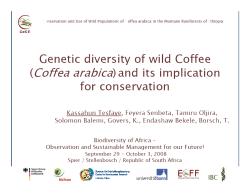| Details of the presentation |
| Presentation |
Oral presentation |
| Title |
Genetic diversity of wild coffee and its implications for conservation
|
| PDF Download |
 Download PDF (Filesize 8.7 MB)
Download PDF (Filesize 8.7 MB)

|
| Short title |
Genetic diversity of wild coffee
|
| Author(s) |
Tesfaye, K.(1); Senbeta, F.(2); Oljira, T.(3); Balemi, S.(4); Govers, K.(5); Bekele, E.(1); Borsch, T.(5)
|
| Presenting author |
Kassahun Tesfaye
|
| Institution(s) |
(1) Department of Biology, Addis Ababa University; (2) Ethiopian Coffee Forest Forum; (3) Department of Biology, Haromaya University; (4) Department of Biology, Jimma Teachers Training College; (5) Botanical Garden and Botanical Museum of Berlin-Dahlem & Institute for Biology/Botany, Free University of Berlin
|
| Keywords |
Coffea arabica; wild coffee; chloroplast genome; genetic diversity
|
| Abstract |
The genetic diversity of wild Coffea arabica from eight regions in the Afromontane rainforest area were studied using different molecular markers to reveal the extent and patterns of the diversity of the coffee populations. Based on chloroplast genome sequence data, C. arabica appears as a species that arose in rather recent times through a single allopolyploidization event involving the ancestor of C. eugenioides as a mother. Even though large portion of chloroplast genome were sequenced, no deviating chloroplast haplotypes were encountered in C. arabica. The interregional analysis of wild C. arabica shows a complex pattern of genotype distribution over the different regions; whereby coffee samples collected from some regions are observed to be very diverse, whereas the coffee genotypes from others tend to be more homogeneous and form their own groups. Moreover, the analyses show that wild C. arabica populations generally form a group distinct from landraces. The in-depth genetic diversity analyses of three regions demonstrate a clear differentiation and fine scale spatial patterning within region. The over all genetic diversity results suggest the need for a multi-site in situ conservation approach. Only this type of conservation approach allows capturing the entire genetic diversity found in different wild coffee regions. The outcomes from the genetic diversity assessment are used as the bases for designing in situ gene banks. The ongoing effort of the in situ gene bank establishment allows the conservation of wild coffee-genetic diversity together with the diversity of the associated forest tree species at the peripheral sites of the forest within the same environment.
|
| Congress Topic |
Coffee project
|
| Topic No. |
6.2 |
| Notes |
---
|
| Ref. No. |
508 |
